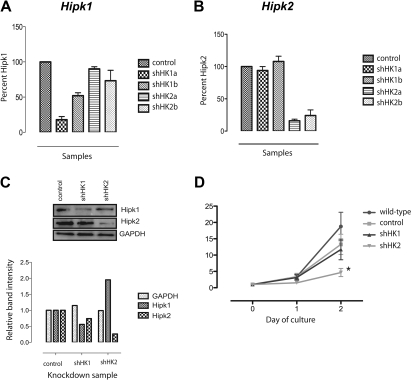Figure 2.
Specific knockdown of Hipk2 inhibits terminal erythroid proliferation. RNAi short hairpins designed to specifically target Hipk1 (shHK1a and b) or Hipk2 (shHK2a and b) were cloned into retroviruses and infected into Ter119-negative fetal liver cells before culture in Epo-containing media. The control sample refers to a nonspecific shRNA hairpin directed against the firefly luciferase gene. (A-B) Quantitative RT-PCR on RNA isolated from infected cells after 48 hours was performed using primers against Hipk1 (A) or Hipk2 (B); n = 3 (mean ± 2 SEM). Expression levels were normalized to RPS3 and then compared with control-infected cells. (C) Western blot showing reduced HIPK1 and HIPK2 protein by 36 hours as a result of each specific shRNA knockdown; quantification of the bands is included below the blot. (D) Cell counts measured at 24 and 48 hours after retroviral infection; fold increase compared with equal starting cell numbers (2 × 105) at day 0, set to 1; n = 5 (mean ± 2 SEM). *P < .05.

